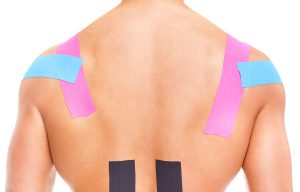
Kinesiotape (K tape) or elastic therapeutic tape, really got popular about 10 years ago with professional athletes.
The kinesiotaping course that I took at that time focused on rehabilitating injured muscles. But after using it at my clinic for a few months, I soon realized it could have much broader applications, like improving back posture!
The magic of how K tape works so well in combination with acupuncture is because acupuncture sets the stage for the tape to do its job better!
When it comes to posture problems, K tape alone is usually not enough to make a noticeable difference – the posture muscles need some help first.
Let’s look at back/neck issues that arise from slouching forward, a problem that many develop when sitting and working at a computer. Some of the posture muscles get into bad habits of not doing their work, and others are doing too much work. The rhomboid muscles between the shoulder blades and the lumbar muscles of the low back are usually not activated and working enough to keep the back straight.
On the other hand, the big upper trapezius muscles that hold the head up, and run from the shoulders to the back of the head, are often very over active and “tight” or “knotted” and can’t relax (causing tension headaches in some!). They are working hard to hold the head up while the neck is kinked up looking at the screen or looking down at your phone.
Basically, acupuncture works to improve posture-related pain by “resetting” the inactive muscles to get them firing again, and relaxing the over-active muscles to get them responsive again.
So, acupuncture makes functional changes and can give some relief for a few days, but the pain can return unless one establishes different posture habits in the back. This is why we work with clients to make posture changes, learn what exercises can help, and understand what should be avoided.
Kinesiotape can do its job better after the acupuncture treatment; K-tape retrains your posture muscles to hold you up more efficiently.
First of all, K tape does NOT work by supporting joints or muscles directly like the old fiber tape (unless you apply it with a full 100% stretch). K tape is is sticky on one side, porous and really stretchy — it can almost double in length. When applied correctly, it can be anchored at both ends without stretch and attached in the middle with the desired amount of stretch.
K-tape works by activating posture muscles like the rhomboids and lumbar muscles.
The most common principle is to put K tape on with about a 50% stretch, to allow the muscle and associated soft tissues to stretch it more in one direction, but with resistance, but then to keep a constant tug back the other way too. The position of limb/back when the K tape is applied makes all the difference to what it is doing. So for posture, we apply the tape with about a 50% stretch where “neutral” or stable normal position of the shoulders or position of the back “should” be.
The tape then becomes a dynamic system, resisting backward to set a better neutral posture, but still allowing the back or shoulders to flex forward.
All the while reminding you to stay in the neutral position (more desired posture). In technical lingo, this is called “proprioceptive cuing”. The tape is “tricking” you into minimizing the stretch, since in the beginning at least, your body’s awareness (proprioceptive system) is thinking the you are being stretched. At first you notice the tape’s effects, but after a few hours, it does its work without you even noticing.
If you haven’t experienced K tape before, ask about it next time you are in!


